Have you ever come across a competitor’s ad and thought, “Why does this work so well?”
You’re not alone—every marketer has had that moment.
When it comes to digital marketing, the right ad copy can make all the difference. The right words can turn a casual viewer into a loyal customer, while the wrong ones can cause them to scroll right past.
But writing ad copies that resonate isn’t always that simple—it’s a mix of strategy, creativity, and understanding your audience.
So, where do you start?
As we mentioned in the beginning - one of the best strategic moves is by learning from your competitors’ ads. By analyzing their ad copy successes and what they are doing right (and wrong), you can extract tactics to refine your own ad copy and stand out in a crowded digital space.
In this blog, we’ll cover how you can craft winning ad copies through an effective competitor ad analysis.
Let’s dive in!
How ad copies drive conversions
Words have power.
And nothing proves the above-mentioned statement more than an ad copy that converts.
Ad copies are often the first point of contact between your brand and potential customers. These snippets are like your virtual sales pitch—a chance to grab attention and make an impression in just a few seconds.
Here’s what effective ad copies do:
- Grabs attention: When written with a mix of compelling keywords, features and solutions, your ad copy will stand out in the crowd.
- Drive click-through rates (CTR): As long as it includes a compelling message, your ad copy can prompt your potential customer to take action, thus boosting ROI.
- Convert leads into customers: Strong ad copies paired with powerful CTAs drive conversions.
Here’s a perfect example of a converting ad copy from a Google Ad by Semrush:
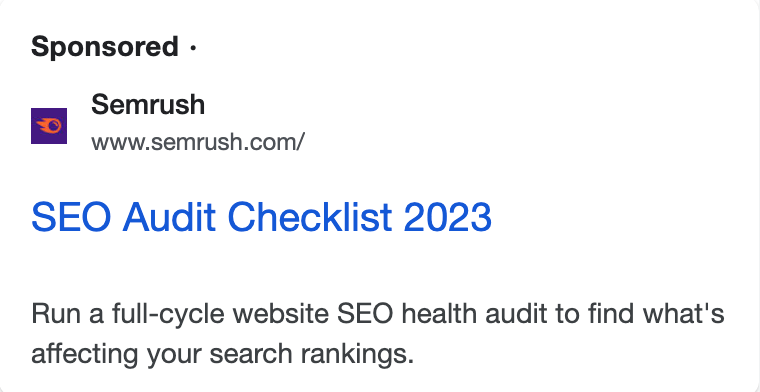
Semrush’s ad is the perfect example of a converting ad copy.
"Run a full cycle SEO health audit to find what’s affecting your search rankings"
Now why this works?
Because it communicates the value that the audience might get by taking the certain action —thus persuading the audience to TAKE that action.
Let's take a look at another successful ad copy from Meta library:
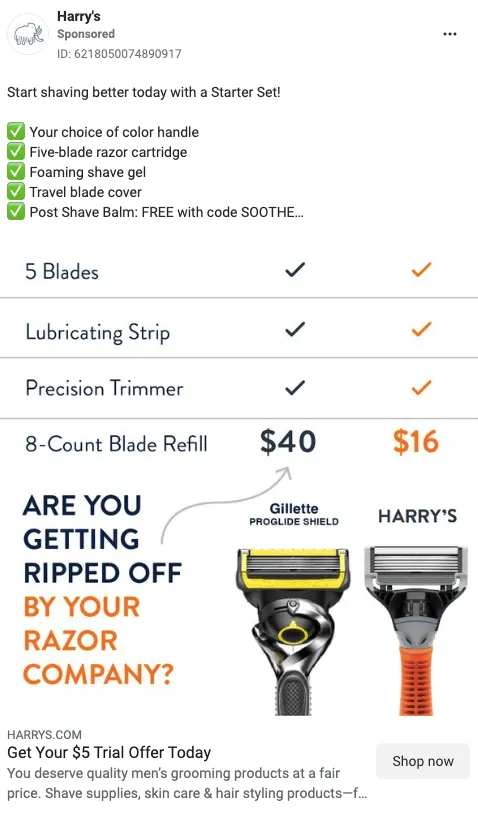
Harry’s conveys the reasons why someone should convert.
Harry’s has been a tough competitor to Gillette and other razor brands for years.
Here’s why this ad copy works: because the ad copy breaks down the benefits that the audience would get from using Harry’s into small digestible information.
Furthermore, it includes a discount code for that final nudge. The comparison imagery works as cherry on top!
Also, did you know that your ad copy can directly impact your Ad Rank and Cost Per Click (CPC)?
Platforms like Google Ads evaluate ad relevance, expected CTR, and landing page experience. All of these are influenced by your ad copy. So, the better your ad copy matches searcher intent (and delivers value), the higher your Quality Score.
And a higher Quality Score means:
- Better ad placements
- Lower CPC
- Higher ROI
When you study competitor copy, pay attention to what might be boosting their score like clear value statements, benefit-driven headlines, and matched landing pages.
Now, let’s dive deep into learning effective competitor ad analysis to write the perfect ad copy.
What is competitor ad copy analysis
Competitor ad analysis is the process of studying your competitors' ads to uncover their strategies, identify gaps, and gather insights to improve your own ad campaigns.
And a part of this process is analyzing competitor ad copy.
Competitor ad copy analysis is the targeted dissection of your competitors' ad messaging, including their keywords, tone, CTAs, and value propositions, to identify what works, what doesn’t, and how to refine your own ad copy.
How to analyze competitor ad copy
Many marketers are not comfortable with the idea of deriving inspiration from competitor ad copy.
Some even consider it stealing!
But hear us out: we are going to step into 2025 in only a few weeks. And if you’re not analyzing your competitor’s ad campaigns to strategize your next ad campaign, you’re missing out big time!
Competitor ad analysis is not about copying—it’s about understanding the landscape and crafting ads that truly stand out.
By studying your competitor’s ad copy, you can easily uncover the secret sauce behind their success (or failure), understand what works best for your industry (keywords, USP, etc.), and derive inspiration (not copy or steal) for your next ad.
By identifying the gaps in your competitor's ad copy and filling them up, you can easily stand out in the crowd!
You can analyze your competitor’s ad copy in 4 easy steps:
1. How to find competitor ads
Here’s how to track your competitors’ ad strategies:
Use tools like SEMrush and SpyFu: These platforms can play a great role in helping you figure out which keywords your competitors are targeting and how their ads are performing.
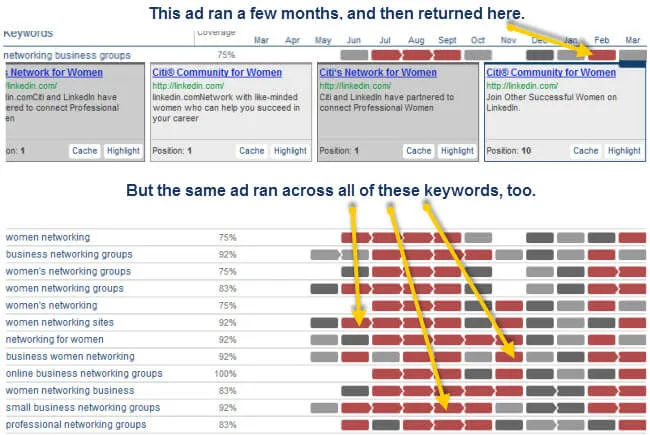
Spyfu is a great tool when it comes to finding competitor ads.
Use Kaya’s Competitor Ad Intelligence Tool (COIN): Our standalone tool, COIN, gives you a top-down view of all your competitors' activities across all ad channels like Google Ads and Facebook. As a result, besides tracking all your competitors' ads from a single interface you can also access certain actionable insights like how much should your ad spend be, a new ICP, or just what we have been looking for here: ad copy ideas!
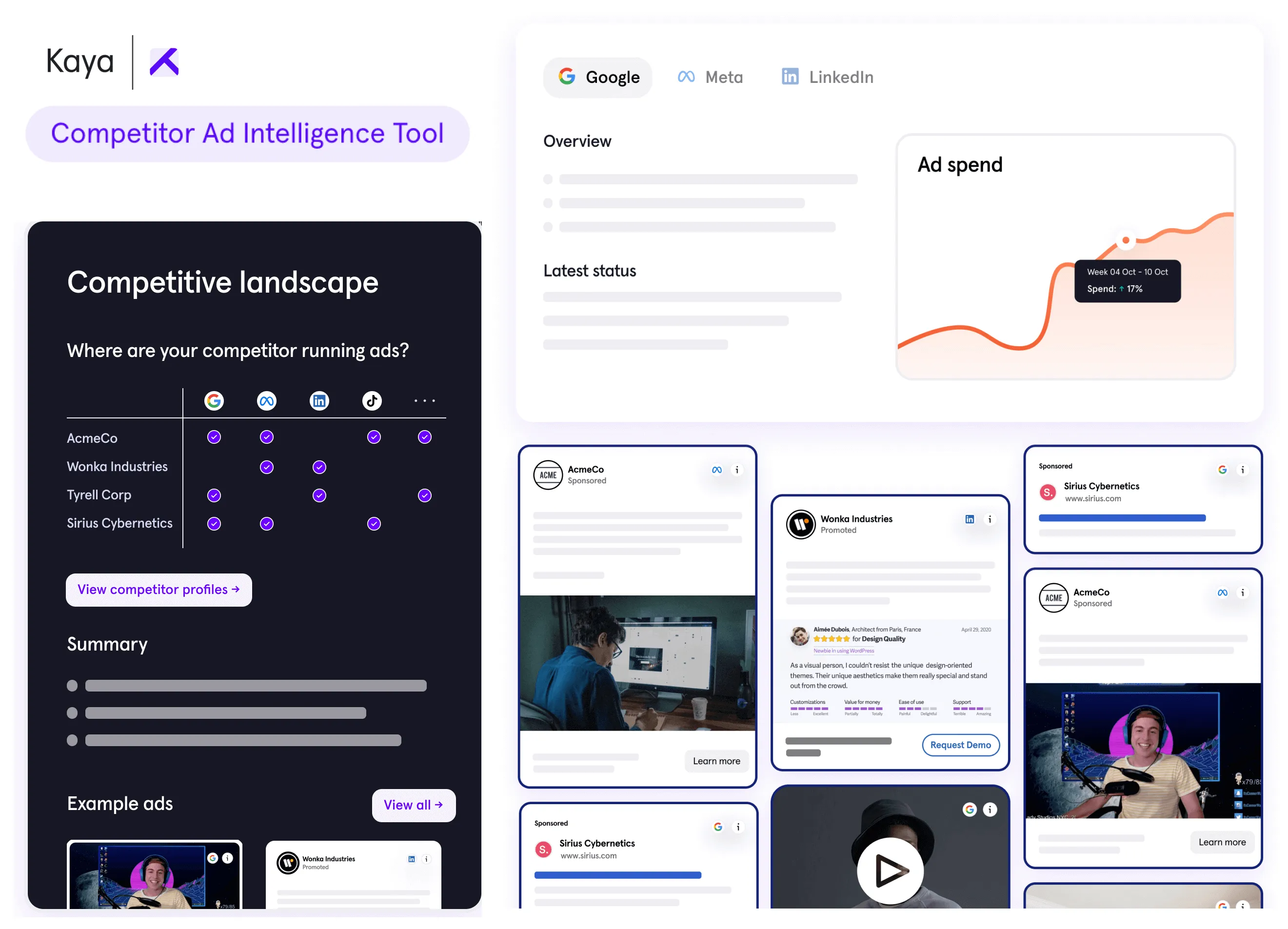
COIN is the perfect all-in-one tool for competitor ad research.
Check ad libraries: Almost all ad channels have their own ad libraries. While Google has Ads Transparency Center, Facebook has Meta Ad Library, LinkedIn has LinkedIn Ad Library, and more — there are plenty of ad repositories for you to research for your ad copy.
2. What to look for in competitor ads
When approaching an ad analysis, it is important that you have a framework in mind. When analyzing competitor ad copy, ask yourself the following questions:
| Question | Rationale |
| What keywords are they using? | If your chosen competitor ad is a successful one, chances are fat that these keywords might have played a role in bringing the success. Hence, as long as they keywords are aligned to your USP and are non-branded, you can use them for your next ad copy. |
| What tone and style do they adopt? Is it formal, casual, or playful? | If your brands are ALMOST similar, their tone might work for yours as well. |
| How do they structure their CTAs? | Almost all ad copy have a CTA, but only a few can convert. So if your chosen ad is a successful one, feel free to take some inspiration from the ad copy structure. |
| Are they highlighting pain points or benefits? | A key way to resonate with your audience is to reinstate what they want to hear. Go through your competitor’s ad copy and see how they have built the problem vs solution framework. |
| What type of persona they are trying to attract through this ad copy? | Some keywords are more B2B, some are more B2C. Identifying which keywords to target which audience base is crucial to making your ad copy work. |
| What type of ad format is this? | The format (search vs display vs video) changes how much copy space you get, and what message style works best. |
| Are they using urgency, scarcity, or social proof? | Psychological triggers often influence conversions. Watch for phrases like “limited time,” “only 3 left,” or “trusted by 10,000+.” |
| Does the copy align with the landing page? | A mismatch in messaging often causes drop-off. Analyze how consistent their message is throughout the user journey. |
3. Study their landing pages
A great ad doesn’t exist in isolation—it’s part of an entire user journey.
Many ads suffer from a high CTR but low conversion because of mismatched messaging between ad copy and landing page copy.
Study how your competitors’ landing pages align with their ads and copy. Are they fulfilling promises, or is there a disconnect?
Look for areas where you can outperform them. For example, if their landing page messaging doesn’t align with the messaging of their ad copy, you will know what to do with your own.
4. Apply your learnings
Competitor analysis isn’t about cheating or stealing—it’s about learning. The final step of competitor ad copy analysis should be to apply to work whatever you’ve learned so far.
Here’re some examples of how to apply those lessons effectively:
- Use the keywords that your competitors have used and seen success with — as long as they are relevant to you.
- Again, instead of simply emulating them, you can experiment with exclusivity, such as: if your competitor is going after a broad audience, you can go after a niche one.
- Use competitor insights to sharpen your USP and highlight what makes you unique.
Why testing competitor ad copy is non-negotiable
Just because something worked for your competitor doesn’t mean it’ll work for you. The secret to truly leveraging competitor ad copy is testing.
A/B testing different ad copy versions, especially ones inspired by competitors can reveal what resonates most with your unique audience.
You can:
- Test tone variations: professional vs casual
- Swap out CTAs: “Sign up free” vs “Get your demo”
- Run experiments on keyword-focused vs emotion-led copy
Use Google Ads’ experiments, Meta A/B tests, or tools like VWO or Optimizely to test different versions. What wins the test often becomes your highest-performing evergreen ad.
Legal boundaries of competitor-based ad copy
Before you take inspiration from your competitors, here’s something critical to keep in mind: legality and ad platform policies.
You can analyze and learn from competitors, but copying word-for-word or using their brand names without permission can lead to:
- Google Ads disapprovals
- Meta Ad Account restrictions
- Even legal notices from competitors
Instead, keep it ethical:
- Use non-branded keywords unless you're targeting in a comparative (and compliant) way
- Avoid false claims (“We’re better than X” without proof)
- Stay original in tone, structure, and value proposition
Competitor analysis should guide your creativity, not replace it.
Additional tips to write good ad copies
Writing ad copies can feel daunting, but it doesn’t have to be. Here are some additional ad copy writing tips that if followed properly can make your ads shine bright.
Let’s drive in!
1. Understand your audience deeply
Every successful ad starts with one question: Who are you talking to?
Spending time to get to know your audience better plays a crucial role in making your ad messaging more resonating.
What are their pain points? What excites them? What keeps them up at night?
The better you understand your target customers, the more personal and impactful your ad copy will be.
Here’s an additional hack if you want to level up your ad copy game: create customer personas to visualize your ideal audience.
Here’s an example of customer persona: Startup Sarah
| Traits | |
| Demographic |
|
| Psychographic |
|
| Behavioral Attribute
|
|
Now, you can easily tailor your messaging to speak directly to Sarah’s needs. Chances are high that your ad will be targeting more than one persona. So create as many as required.

Example of customer persona; source: Product School
2. Make emotions your secret weapon
People don’t just buy products—they buy solutions to problems, dreams, and emotions.
A great ad copy taps into those emotions, whether it’s excitement, relief, or even FOMO (fear of missing out).
Here’s an example by Leapwork:
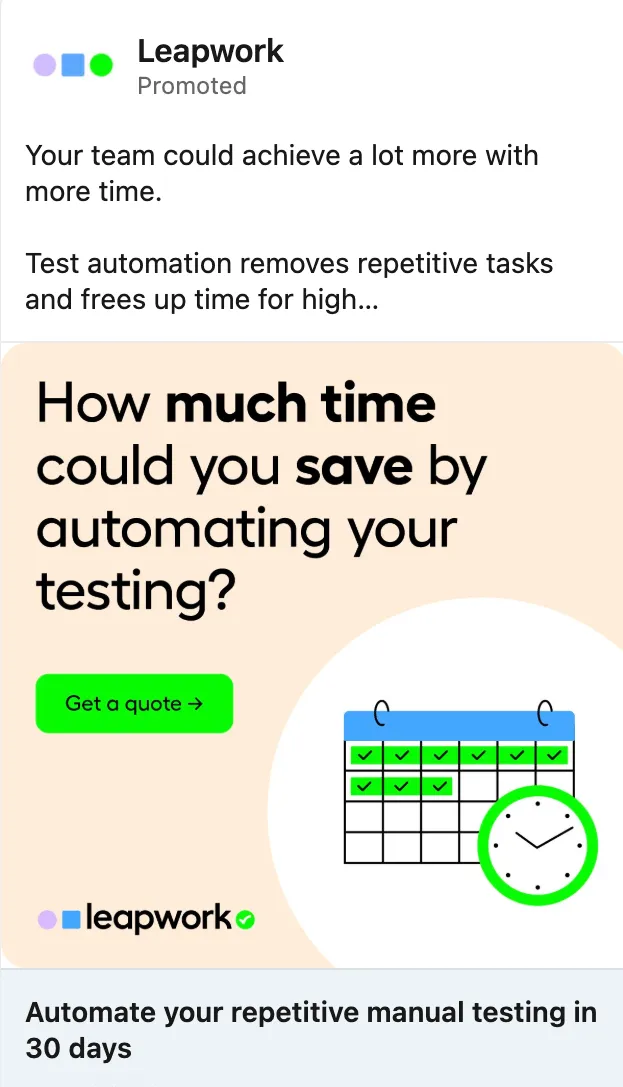
Leapwork uses emotion in ad copy to drive conversion.
“Your team could achieve a lot more with more time. Test automation removes repetitive tasks and frees up time for higher-value work. Curious how much time and money you could save? Request a quote now.”
Besides including a CTA, this copy evokes the “what if” factor in the mind of an audience — thus persuading them to take an action.
3. Be clear, concise, and impactful
You’ve got just a few seconds to make your case. So don’t waste them with fluff. Use simple, direct language that conveys your message without unnecessary jargon or claims.
Let’s do an exercise with this example here:
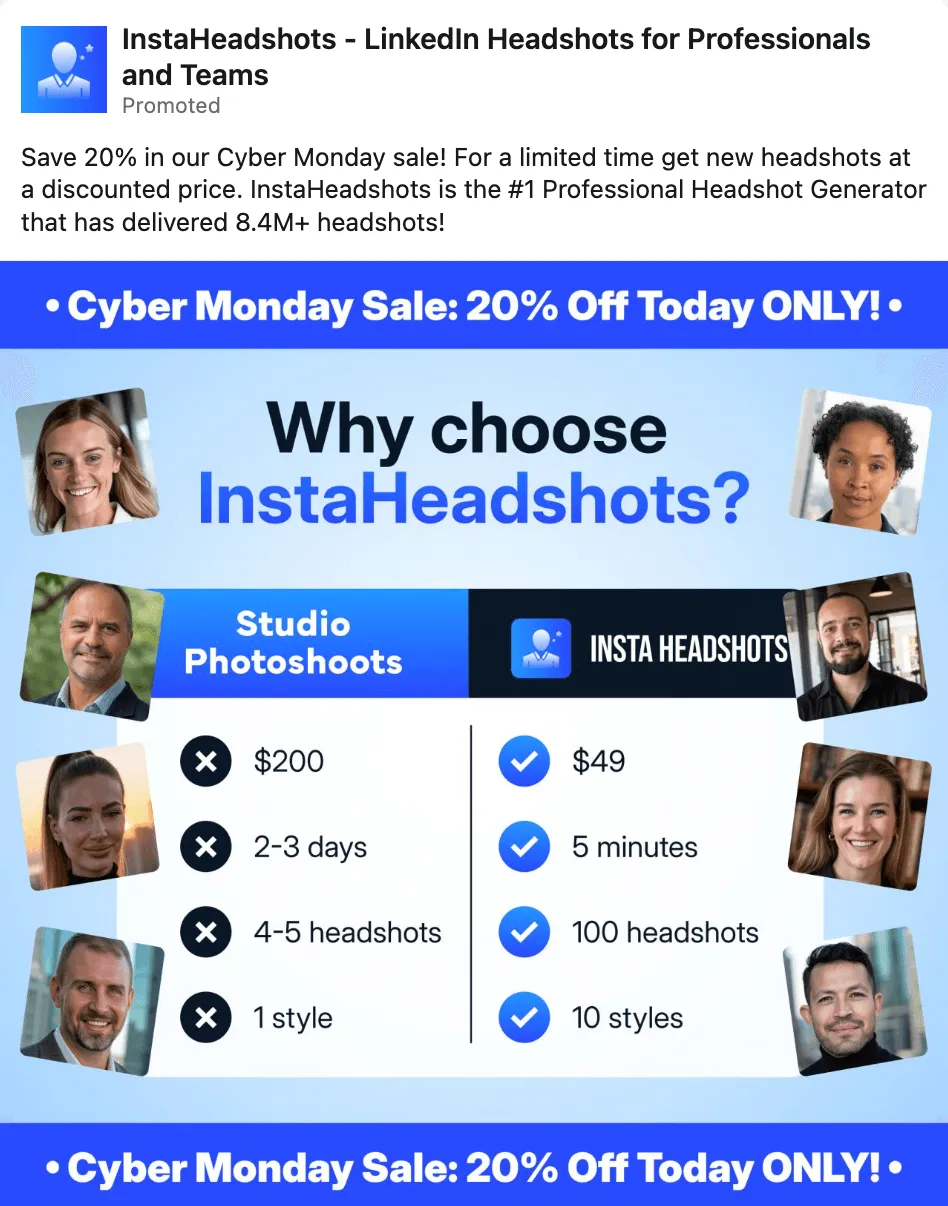
The ad copy is too cluttered to convey the message.
It says:
“Save 20% in our Cyber Monday sale! For a limited time get new headshots at a discounted price. InstaHeadshots is the #1 Professional Headshot Generator that has delivered 8.4M+ headshots!”
Now, the reason it doesn’t work is because it seems too mouthful with the words.
However, we could restructure it in the following way:
“Save 20% this Cyber Monday with InstaHeadshots. Limited time only!”
Chopping off self-proclaimed accolades not only makes it sound more professional and credible, but also more concise.
4. Highlight your unique selling proposition (USP)
What makes you different from your competitors?
It is your USP aka unique selling proposition.
And the best way to use it is conveying it through your ad copy.
Whether it’s speed, price, quality, or features, your ad copy needs to spell out the value users get from choosing you.
Here’s an example from Fireflies.ai:
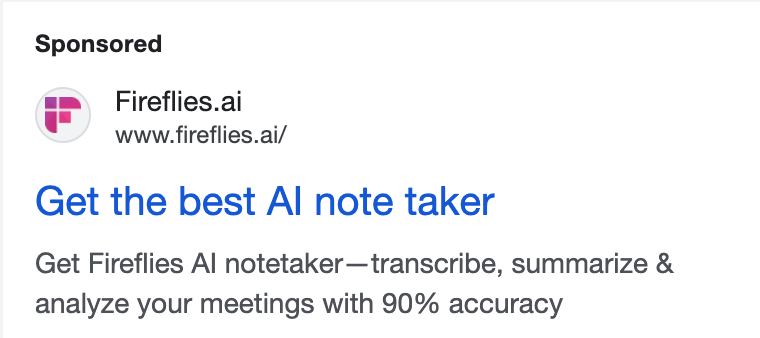
Fireflies.ai covers the USP in the ad copy.
Here, the ad copy covers all of the unique value offerings of the product.
And that’s how you should use your USP in your ad copy.
5. Write CTAs that inspire action
A good call-to-action (CTA) is like a nudge that gives the final push to your users and tell them exactly what to do next.
The key to crafting an effecting CTA is to make it direct, actionable and irresistible.
The attention span of your audience is on the very edge when they come across the CTA. Hence, you need to be super clear about what action you’d like them to take.
Otherwise, they will scroll away and you’d be left with another ineffective ad copy.
Here are some examples to learn from:

Expedia's ad copy contains actionable CTAs.
Here, Expedia specifically tells you what you need to do. Starting from comparing the process (so that you know better) to reserving— it covers your entire decision making journey.
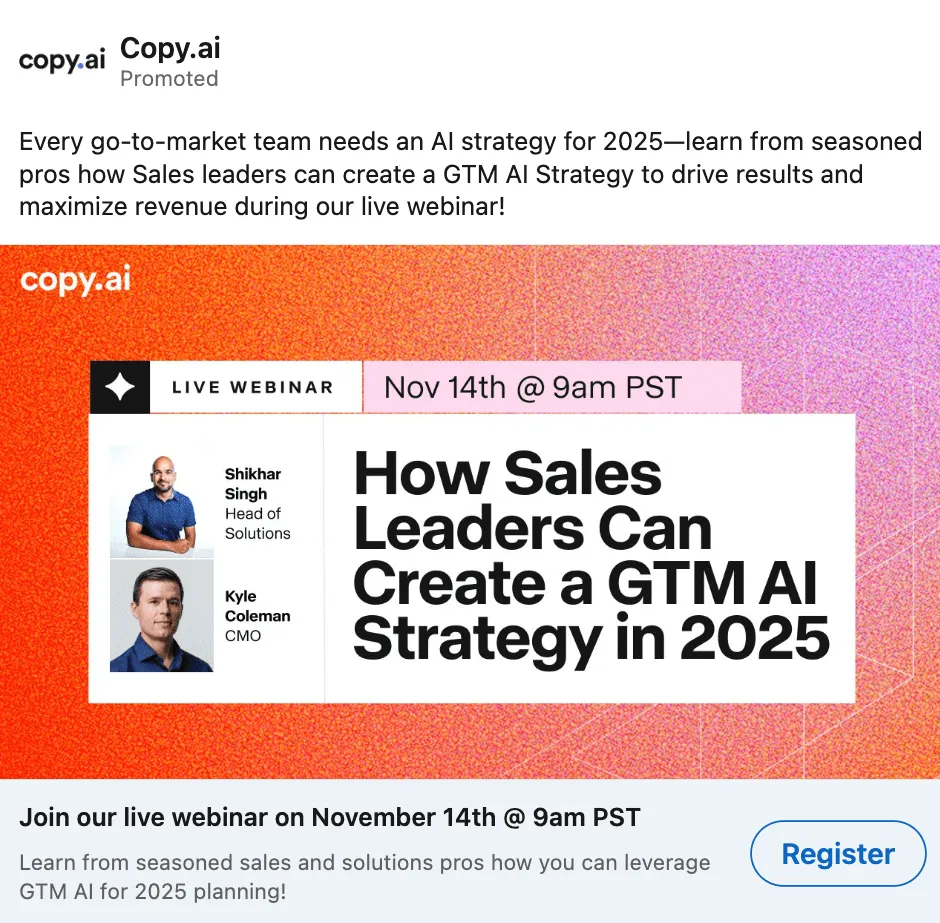
Copy.ai tactfully uses the headline to make the CTA button stand out more.
Here’s another example from Copy.ai:
By asking specifically join the webinar, mentioning the date and time and using the “Register” button, this ad not only makes the entire process actionable and helps attract an audience genuinely interested in the topic.
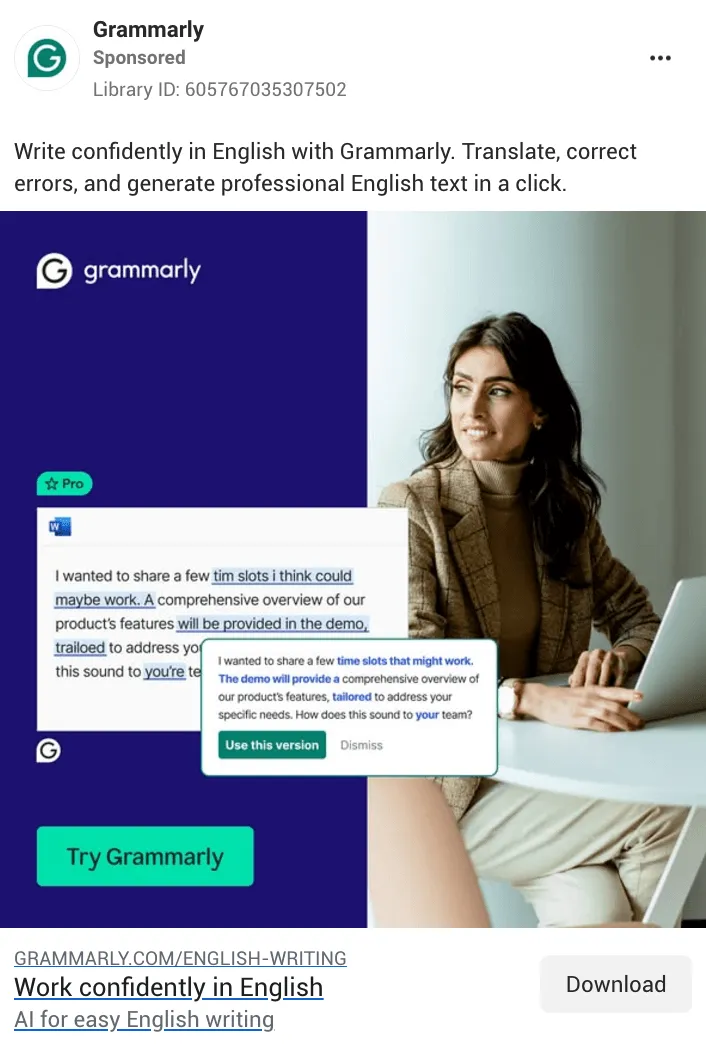
Lastly, we have this example from Grammarly:
The ad copy conveys the outcome behind the action before jumping into it— making it more convincing for the audience to actually download Grammarly.
A big reason some ad copies flop is because they misalign with search intent. That’s why, it is important your copy aligns with the intent. Such as:
- Transactional intent: Use CTAs like “Get started,” “Buy now,” “Claim offer”
- Informational intent: Go for “Learn how,” “Download guide,” “Explore”
Competitor ad copy that converts usually nails this alignment—so study the intent behind their messaging, not just the words.
Key takeaway
Too much information?
Here’s a summarized version of everything we have learned about writing ad copy from competitor ads and more:
- Track competitor ads using tools like SEMrush, SpyFu, or Kaya’s Competitor Ad Intelligence Tool.
- Analyze keywords, tone, CTAs, pain points, and benefits in competitor ads.
- Study how their landing pages align with ad messaging and identify gaps to outperform them.
- Understand their target audience personas and adapt insights for your ads.
- Focus on what works (e.g., successful keywords or emotional hooks) and innovate to stand out.
- Know your audience deeply through personas and tailor your messaging to their pain points.
- Tap into emotions like excitement, relief, or FOMO to resonate.
- Be concise and clear, avoiding fluff and jargon.
- Highlight your USP to emphasize what makes your brand unique.
- Write strong, actionable CTAs to guide users effectively.
FAQ
What is competitor ad copy analysis?
What is competitor ad analysis?
How do you analyze competitor's ads?
How do you find competitor paid ads?
Final thoughts
In paid marketing, where competition is fierce and attention spans are short, every edge counts.
Taking inspiration from competitor ads and creating your own version gives you that edge.
By studying your competitors and applying the strategies mentioned above, you can craft ad copies that don’t just compete but dominate.
It never is about copying—it’s about learning, innovating, filling in the gaps, and crafting ads that truly connect with your audience.
With Kaya’s Competitor Ad Intelligence Tool (COIN), you’re not just guessing—you’re taking a data-driven approach to success. COIN makes it easy to track, analyze, and outperform your competitors.
We recently had the opportunity to work with Venn, a rising name in the fintech industry. The company was having a hard competing with legacy brands and the team didn’t have the capacity required to fill in the gap to get ahead of the competition.
Kaya helped Venn by optimizing their Google Ads campaigns through a rigorous test of keywords, refinement of strategies and years of experience of working with other fintech clients. Furthermore, they enabled full visibility into cohort-level ROAS and consistent iteration cycle; leading to consecutive months of record-breaking signups. Venn soon saw 10x improvement in ROAS, while scaling budget by 2x.
If you’re looking for similar results but don’t have the bandwidth to do it by yourself, you know whom to refer to!

